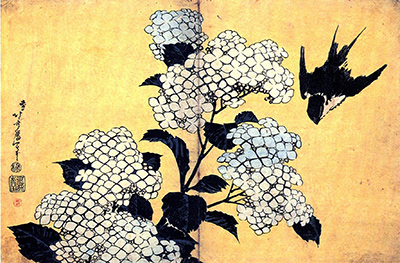Hokusai
Hydrangea and Swallow by Hokusai
Hokusai completed Hydrangeas and Swallow in 1833. At its completion, Hydrangeas and Swallow was untitled, and part of a large body of work by Hokusai known simply as Large Flowers. Hydrangeas and Swallow is another excellent example of Hokusai’s treatment of traditional Japanese natural elements.
This piece, like so many of Hokusai’s paintings, has the pure symbolism seen in many Japanese works. Hydrangeas, abundant and indigenous to Asia, represent the natural beauty of Japan. In Japanese folklore, the hydrangea is symbolic of heartfelt emotion as well as representing heartlessness and frigidity. The swallow in Hydrangea and Swallow represents spring, fertility, and good luck. Together, in Hydrangeas and Swallow, they create a symphonic resonance of winter fading and the rebirth of spring.
Like all other Hokusi work, Hydrangeas and Swallow is in the classic ukiyo-e style of woodblock painting. At the inception of woodblock printing, an image was carved into a single block of wood using an ink wash painting as a template. Special commissions required hand painting after the printing process to add colour. As can be seen in Hydrangeas and Swallow, later adaptations to the process made it possible to use more than one block for each print allowing the use of many colours. This new process, along with the use of water-based inks as opposed to the oil paints used in western woodblock paintings, produced the bold, vibrant paintings of the ukiyo-e style. This is illustrated in Hydrangea and Swallow.
Hokusai’s early life revolved around the woodblock printing process. From the age of 12, Hokusai worked in a shop that was both a library and bookshop. His daily activities would be surrounded by woodblock printed books. At the Age of 14, he went to work as a woodcarvers apprentice and gained expertise in the process. This early experience and his talent as a painter led him to the studio of Katsukawa Shunsho. Shunsho, a master of woodblock painting, specialised in the scenes of the hedonistic pleasure of the time that appealed to the growing merchant class.
